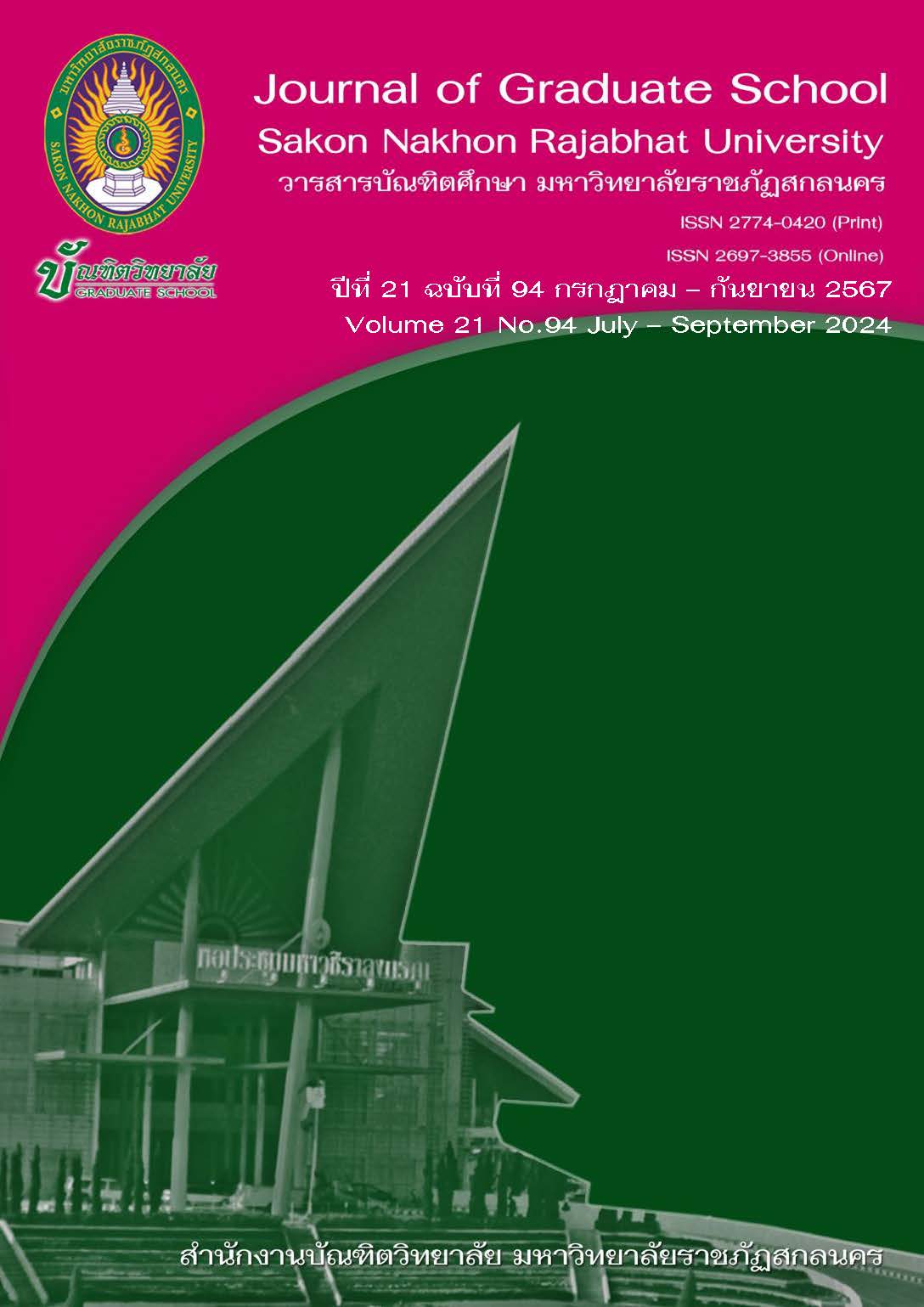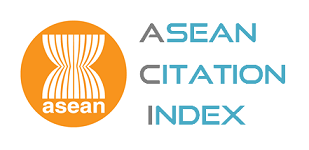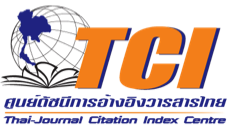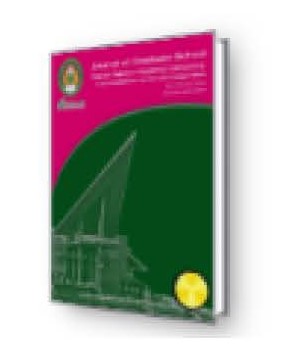DEVELOPMENT OF SCIENCE PROCESS SKILLS AND LEARNING ACHIEVEMENT OF MATHAYOMSUKSA 1 STUDENTS ON THE TOPIC OF HEAT TRANSFER BY USING STEM EDUCATION WITH INFOGRAPHIC
Keywords:
Science Process Skills, STEM Education, InfographicsAbstract
This research aimed to 1) create lesson plans on the topic of Heat Transfer for Mathayomsuksa 1 students using STEM education learning management with infographics to meet the efficiency criteria of 80/80, 2) compare students’science process skills and learning achievement before and after the intervention, and 3) examine the students’satisfaction with the developed learning management. The sample consisted of 40 Mathayomsuksa 1 students at Sawang Daen Din School, during the second semester of the 2022 academic year. The sample was determined using cluster random sampling, with classrooms as the sample units. The research tools comprised STEM education lesson plans with infographics, a science process skills test, a learning achievement test, and a set of questionnaires on satisfaction with the developed learning management. Statistics for data analysis included percentages, averages, and standard deviations. and t–test for Dependent Samples.
The research results found that:
1. The efficiency of lesson plans on the topic of Heat Transfer based on STEM education learning management with infographics reached 82.02/82.46, which was higher than the specified criteria of 80/80.
2. The students’ scientific process showed a significant improvement, with a mean score increased from 45.25 percent to 81.45 percent after the intervention, which was statistically higher than the scores before the intervention at the .01 level of significance.
3. The students’ learning achievement improved significantly, with a mean score increasing from 45.08 percent to 83.17 percent after the intervention, which was higher than the pre–intervention scores at the .01 level of significance.
4. The students’ satisfaction with the developed learning management was overall at the highest level (mean = 4.79).
References
กระทรวงศึกษาธิการ. (2551). หลักสูตรแกนกลางการศึกษาขึ้นพื้นฐาน พุทธศักราช 2551. กรุงเทพฯ: องค์การรับส่งสินค้าและพัสดุภัณฑ์.
_______. (2553). หลักสูตรแกนกลางการศึกษาขึ้นพื้นฐาน พุทธศักราช 2551. กรุงเทพฯ: โรงพิมพ์ชุมนุมสหกรณ์การเกษตรแห่งประเทศไทย.
_______. (2560). หลักสูตรแกนกลางการศึกษาขึ้นพื้นฐาน พุทธศักราช 2551. กรุงเทพฯ: โรงพิมพ์ชุมนุมสหกรณ์การเกษตรแห่งประเทศไทย.
ธีระขัย เอี่ยมผ่อง. (2562). การพัฒนากิจกรรมการเรียนรู้โดยใช้ปัญหาเป็นฐานตามแนวทางสะเต็มศึกษา. กรุงเทพฯ: จุฬาลงกรณ์มหาวิทยาลัย.
ปุญญพัฒน์ โคตรบุตร ต้นสกุล ศานติบูรณ์ และสมาน เอกพิมพ์. (2560). การบูรณาการแนวคิดทางด้านวิทยาศาสตร์ เทคโนโลยีวิศวกรรมและคณิตศาสตร์ (STEM) ในการเสริมสร้างผลสัมฤทธิ์ทางการเรียนและเจตคติต่อวิทยาศาสตร์สำหรับนักเรียนชั้นมัธยมศึกษาปีที่ 1. รายงานสืบเนื่องการประชุมวิชาการและนำเสนอผลงานวิจัยระดับชาติ ครั้งที่ 1. 2-3 มีนาคม 2560. มหาสารคาม: มหาวิทยาลัยราชภัฏมหาสารคาม. 1306-1311.
สถาบันส่งเสริมการสอนวิทยาศาสตร์และเทคโนโลยี (สสวท.). (2557). คู่มือการใช้หลักสูตรวิทยาศาสตร์ฉบับอนาคต ชั้นมัธยมศึกษาปีที่ 1. กรุงเทพฯ: ชุมนุมสหกรณ์การเกษตรแห่งประเทศไทย.
สุริยันต์ คุณารักษ์. (2561). การพัฒนาทักษะกระบวนการทางวิทยาศาสตร์ เรื่อง ชีวิตกับสิ่งแวดล้อมโดยจัดการเรียนรู้แบบสะเต็มศึกษา กลุ่มสาระการเรียนรู้วิทยาศาสตร์ชั้นประถมศึกษาปีที่ 6. วารสารวิชาการหลักสูตรและการสอน มหาวิทยาลัยราชภัฏสกลนคร, 10(27), 34–35.
อาทิตยา พูนเรือง. (2558). การเปรียบเทียบผลสัมฤทธิ์ทางการเรียนและความสามารถในการแก้ปัญหาทางวิทยาศาสตร์ เรื่อง เคมี
ที่เป็นพื้นฐานของสิ่งมีชีวิต โดยการจัดการเรียนรู้ตามแนวทางสะเต็มศึกษา สำหรับนักเรียนชั้นมัธยมศึกษาปีที่ 5. วารสารศึกษาศาสตร์ มหาวิทยาลัยมหาสารคาม, 9(ฉบับพิเศษ), 371–378.
Bloom, B.S. (1956). Taxonomy of Education Objective, Handbook 1: Cognitive Domain. New York: David Mckay.
Chaumklang, S., Pilanthananond, N., & Srisa–ard. (2019). Development of Appropriate management Modelfor STEM Education in Thailand. KKU Research Journal (Graduate Studies) Humanities and Social Sciences, 8(1), 1–12.
Newson, D. & Haynes, J. (2004). Public Relations Writing: Form and Style. California: Wadsworth Publishing.
Polman, J.L. & Gebre, E.H. (2015). Towards critical appraisal of infographics as scientific inscriptions. Journal of Research in Science Education, 52(6), 868–893.
Smiciklas M. (2014). Infographics and the Science of Visual Communication. Retrieved from http://www.socialmediaexplorer.com/digital-marketing/infographics-and-the science-of-visual-communication/. March 27th, 2021.
Downloads
Published
How to Cite
Issue
Section
License
Copyright (c) 2024 Journal of Graduate School Sakon Nakhon Rajabhat University

This work is licensed under a Creative Commons Attribution-NonCommercial-NoDerivatives 4.0 International License.
บทความทุกบทความที่ตีพิมพ์ในวารสารบัณฑิตศึกษา มหาวิทยาลัยราชภัฏสกลนคร ถือว่าเป็นลิขสิทธิ์ของบัณฑิตวิทยาลัย มหาวิทยาลัยราชภัฏสกลนคร










